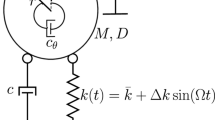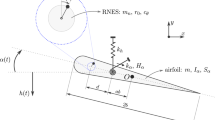Abstract
Dynamics, control, and stability of roll oscillations of a biased ship in regular sea waves are investigated. The ship under roll oscillation is modelled as the classical Helmholtz–Duffing oscillator with strongly nonlinear asymmetric restoring moment characteristics. The incremental harmonic balance method, amended with a pseudo-arc-length continuation approach, is employed to obtain the uncontrolled and controlled frequency responses. The primary and subharmonic responses of the uncontrolled system are examined through the period-doubling route to chaos path. The same ship roll model is then investigated under state feedback control with time delay. In the control scheme, a moving weight is actuated by the delay controller to generate the anti-rolling moment. The stability of periodic responses is studied using the semi-discretization method with extended Floquet theory. Bifurcation points on periodic response branches are identified from the eigenvalue study. The effect of gains and time delay in the feedback loop in controlling the primary and subharmonic responses is investigated. Several chaotic responses obtained through period-doubling route to chaos paths are successfully controlled. Stable, periodic, and steady-state solutions obtained from the IHB method are verified by numerical integration of the equation of motion as and when applicable. Solutions are aided with phase portrait, Poincaré map, time history, and Fourier spectrum for better clarity. It is shown that appropriate selections of control parameters can effectively reduce the roll amplitude to a great extent with the improved measure of stability.

























Similar content being viewed by others
Data availability
The datasets generated and/or analysed during the current study are not publicly available due to its proprietary nature. Supporting data cannot be made openly available, but are available from the corresponding author on reasonable request.
References
Perez, T., Blanke, M.: Ship roll damping control. Annu. Rev. Control 36, 129–147 (2012)
Awad, T., Elgohary, M.A.E., Mohamed, T.E.: Ship roll damping via direct inverse neural network control system. Alex. Eng. J. 57(4), 2951–2960 (2018)
Yin, J.C., Perakis, A.N., Wang, N.: A real-time ship roll motion prediction using wavelet transform and variable RBF network. Ocean Eng. 160, 10–19 (2018)
Avalos, G.O.G., Wanderley, J.B.: Numerical study of forced roll oscillation of FPSO with bilge keel. Ocean Eng. 147, 304–317 (2018)
Irkal, M.A., Nallayarasu, S., Bhattacharyya, S.K.: Numerical prediction of roll damping of ships with and without bilge keel. Ocean Eng. 179, 226–245 (2019)
Jiang, Y., Ding, Y., Sun, Y., Shao, Y., Sun, L.: Influence of bilge-keel configuration on ship roll damping and roll response in waves. Ocean Eng. 216, 107539 (2020)
Crossland, P.: The effect of roll-stabilisation controllers on warship operational performance. Control. Eng. Pract. 11(4), 423–431 (2003)
Alarçin, F., Demirel, H., Su, M.E., Yurtseven, A.: Conventional PID and modified PID controller design for roll fin electro-hydraulic actuator. Acta Polytechnica Hungarica. 11(3), 233–248 (2014)
Li, R., Li, T., Bai, W., Du, X.: An adaptive neural network approach for ship roll stabilization via fin control. Neuro-Comput. 173, 953–957 (2016)
Jin, Z., Zhang, W., Liu, S., Gu, M.: Command-filtered backstepping integral sliding mode control with prescribed performance for ship roll stabilization. Appl. Sci. 9(20), 4288 (2019)
Liang, L., Sun, M., Shi, H., Luan, T.: Design and analyze a new measuring lift device for fin stabilizers using stiffness matrix of Euler-Bernoulli beam. PLoS ONE 12(1), e0168972 (2017)
Sun, M., Luan, T., Liang, L.: RBF neural network compensation-based adaptive control for lift-feedback system of ship fin stabilizers to improve anti-rolling effect. Ocean Eng. 163, 307–321 (2018)
Perez, T., Mogens, B.: Ship roll damping control. Annu. Rev. Contr. 36(1), 129–147 (2012)
Su, X., Gao, Y., Zhao, R.: Roll attitude controller design for ships at zero speed. Int. J. Fuzzy Syst. 20, 611–620 (2018)
Jiguang, S., Lihua, L., Songtao, Z., Jiming, W.: Design and experimental investigation of a GA-based control strategy for a low-speed fin stabilizer. Ocean Eng. 218, 108234 (2020)
Marzouk, O.A., Nayfeh, A.H.: Control of ship roll using passive and active anti-roll tanks. Ocean Eng. 36, 661–671 (2009)
Holden, C., Fossen, T.I.: A nonlinear 7-DOF model for U-tanks of arbitrary shape. Ocean Eng. 45, 22–37 (2012)
Kapitanyuk, Y.A., Proskurnikov, A.V., Cao, M.: Optimal controllers for rudder roll damping with an autopilot in the loop. IFAC-PapersOnLine. 49(23), 562–567 (2016)
Wang, Y.Y., Chai, S.H., Khan, F., Nguyen, H.D.: Unscented Kalman filter trained neural networks-based rudder roll stabilization system for ship in waves. Appl. Ocean Res. 68, 26–38 (2017)
Fossen, T.I., Pettersen, K.Y., Galeazzi, R.: Line-of-sight Path following for Dubins Paths with adaptive sideslip compensation of drift forces. IEEE Trans. Contr. Syst. Technol. 23(2), 820–827 (2015)
Zhang, J., Sun, T.R., Liu, Z.L.: Robust model predictive control for path-following of underactuated surface vessels with roll constraints. Ocean. Eng. 143, 125–132 (2017)
Peng, Z.H., Wang, J.: Output-feedback path-following control of autonomous underwater vehicles based on an extended state observer and projection neural networks. IEEE Trans. Syst. Man Cybern. Syst.. 48(4), 535–544 (2018)
Liu, C., Li, C., Li, W.: Computationally efficient MPC for path following of underactuated marine vessels using projection neural network. Neural Comput. Appl. 32(11), 7455–7464 (2020)
Yan, Z., Zhang, X., Zhu, H., Li, Z.: Course-keeping control for ships with nonlinear feedback and zero-order holder component. Ocean Eng. 209, 107461 (2020)
Nayfeh, A.H., Khdeir, A.A.: Nonlinear rolling of ships in regular beam seas. Int. Slip Build. Progress. 33, 379–394 (1986)
Szemplinska-stupnicka, W.: Secondary resonances and approximate models of routes to chaotic motion in nonlinear oscillators. J. Sound Vib. 113, 155–172 (1987)
Thompson, J.M.T.: Designing against capsize in beam seas: recent advances and new insights. Appl. Mech. Rev. 50, 307–327 (1997)
Bhattacharya, R.: Dynamics of Marine Vehicles, pp. 1–12. Wiley, New Jersey (1978)
Wassermann, S., Feder, D.F., Abdel-Maksoud, M.: Estimation of ship roll damping—A comparison of the decay and the harmonic excited roll motion technique for a post panamax container ship. Ocean Eng. 120, 371–382 (2016)
Chatterjee, S.: Vibration control by recursive time delayed acceleration feedback. J. Sound Vib. 317, 67–90 (2008)
Yusuf, A., Inc, M., Aliyu, A.I.: Conservation laws, soliton-like and stability analysis for the time fractional dispersive long-wave equation. Adv. Differ. Equ. 319, 1024 (2018)
Mitra, R.K., Banik, A.K., Chatterjee, S.: State feedback control of surge oscillations of two-point mooring system. J. Sound Vib. 386, 1–20 (2017)
Mitra, R.K., Banik, A.K., Chatterjee, S.: Response of a harmonically forced dry friction damped system under time-delayed state feedback. J. Computat. Nonlinear Dyn. ASME 13, 031001–031011 (2018)
Narayanan, S.: Nonlinear dynamics of a two-dimensional airfoil by incremental harmonic balance method. J. Sound Vib. 226(3), 493–517 (1999)
Mitra, R.K., Banik, A.K., Datta, T.K., Chatterjee, S.: Nonlinear roll oscillation of semisubmersible system and its control. Int. J. Non-Linear Mech. 107, 42–55 (2018)
Funding
The authors declare that no funds, grants, or other support was received during the preparation of this manuscript.
Author information
Authors and Affiliations
Contributions
All authors contributed equally to the present research work. All authors read and approved the final manuscript.
Corresponding author
Ethics declarations
Conflict of interest
The authors have no relevant financial or non-financial interests to disclose.
Additional information
Publisher's Note
Springer Nature remains neutral with regard to jurisdictional claims in published maps and institutional affiliations.
Appendix A: root locus plots
Appendix A: root locus plots
Close-loop transfer function from Eq. (2) is written as
The close-loop control system is shown in Fig. 26.
Since \(G(s)=1/({s}^{2}+1)\), the open loop transfer function is expressed by
Since
For \({g}_{v}=0\) (or \({g}_{v}/{g}_{d}=0\)), and \({\tau }_{d}=0.1\), the root locus plot (refer Eq. A.4) of positive displacement feedback is shown in Fig. 27.
For \({g}_{d}=0\) (or \({g}_{d}/{g}_{v}=0),\) and \({\tau }_{d}=0.1\), the root locus plot (refer Eq. A.5) of the negative velocity feedback is shown in Fig. 28.
Rights and permissions
Springer Nature or its licensor (e.g. a society or other partner) holds exclusive rights to this article under a publishing agreement with the author(s) or other rightsholder(s); author self-archiving of the accepted manuscript version of this article is solely governed by the terms of such publishing agreement and applicable law.
About this article
Cite this article
Kumar, R., Mitra, R.K. Controlling period-doubling route to chaos phenomena of roll oscillations of a biased ship in regular sea waves. Nonlinear Dyn 111, 13889–13918 (2023). https://doi.org/10.1007/s11071-023-08605-5
Received:
Accepted:
Published:
Issue Date:
DOI: https://doi.org/10.1007/s11071-023-08605-5







